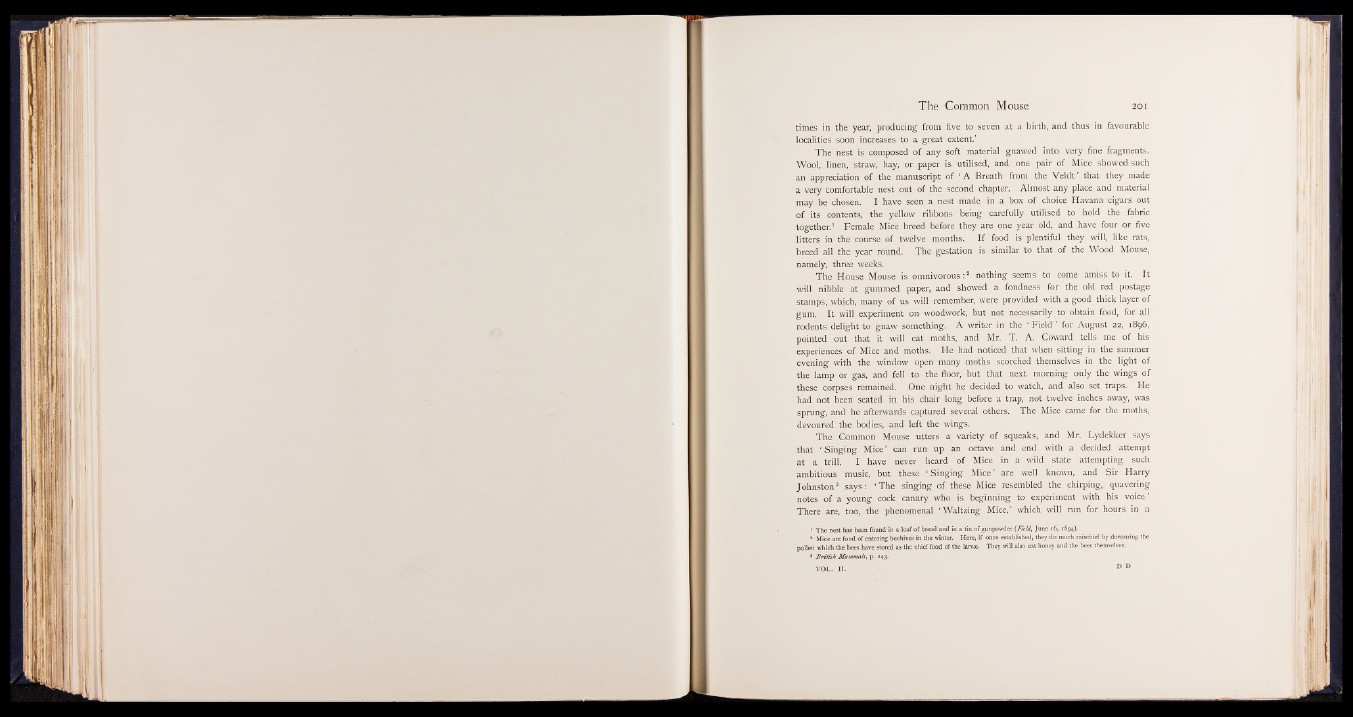
times in the year, producing from five to seven at a birth, and thus- in favourable
localities soon increases to a great extent.’
The nest is composed of any soft material gnawed into very fine fragments.
WooSjlinen, straw, hay, or paper is utilised, and one pair ofri'Mitt showed such
an appreciation of the manuscript of ‘A Breath from the Veldt’ that they made
a vetyS'comfortable nest out of the second chapter. Almost any place and material
may be chosen. I have seen! a nest made in a box of choice Havana cigars out
of its contents, the yellow ribbons being carefully utilised to hold the fabric
together.1 Female Mice breed befdjii they are one year old, and have four or five
litters in the course of twelve months. If food is plentiful they will, like rats,
breed all the year round.' The gestation is Similar to tb a tK the Wood. Mouse,
namely, three, weeks.
The House Mouse is^om nilc® s: * nothing seems to, R u e amiss to it. It
will nibble at gummed paper, 0 d showed a fondness fogth ^fK t red postage
stamps, which, manyl|lf ,us will remember, were provided with a good thick layer of
gum. It will experiment on woodwork, but not necessarily to obtain, food, for all
rodents delight to gnaw something. A writer in the ‘Field’ for August 22, 1896,
pointed out that it will eat moths, and Mr. T. A. Coward tdjjg me of his
experiences of Mice and moths. He had noticed that when sitting in the summer
evening with the window open many moths scorched themselves in the light of
the lamp or gas, and fell to the floor, but that next morning only the wings of
these corpses remained. One night he decided to watch, and also set traps. He
had not been seated, in his chair long before a trap, not twelve inches away, was
jj|rung, and he afterwards captured: several1, others, IChe MiHcameifOr the moths,
devoured the bodies, and left the wings.
The im rno n Mouse utters a variety ofBueaks, and Mr, lydekker says
that ‘ Singing Mfcfl| can run up an octave and end with a decided attempt
at a trill. I have never heard of Mice in a wiljgstate attempting such
ambitious m u ||i but tbest , ‘ Singing M icfiare well known,Hnd Sir Harry
Johnston* says: ‘The singing® these Mice resembled the chirping, quavering
notes of a young cock canary who beginning to- experiment wit! his voice.’
There are, too, the phenomenal ‘Waltzing Mice,’ which will'itul for hours in a
1 The nest has been found in a loaf of bread and in a tin of gunpowder (Field, June 16, 1894).
2 Mice are fond of entering beehives in the winter. Here, if once established, they do much mischief by devouring the
pollen which the bees have stored as the chief food of the lame. They will also eat honey and the bees themselves.
3 British Mammals, p. 243.
VOL. II. D D